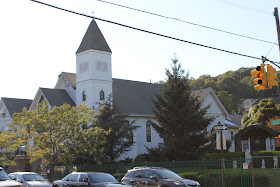 According to the Advance the other day, the old heart of the original Staten Island Hospital, the Smith Infirmary, is about to end its days. After thirty years of neglect it's been deemed unsound and unsafe by HPD and the Buildings Dept.
According to the Advance the other day, the old heart of the original Staten Island Hospital, the Smith Infirmary, is about to end its days. After thirty years of neglect it's been deemed unsound and unsafe by HPD and the Buildings Dept. I am of mixed emotions about the matter. It's sad that such a magnificent building has been allowed to go to ruin but then it is a dangerous site that could simply collapse.
The city did nothing to preserve it but then it really had no obligation to do so. It was a piece of private property sold to a private developer.
That the developer appears to have been a con artist and the condos actually built in the newer building were ultimately abandoned is not the city's fault either.
 If it goes, which is most likely, I'll miss it. It's been part of my landscape my entire life (literally - I was born in the old hospital). Growing up and living on Cebra Avenue most of my life its literally been in my line of sight more days than not. One of my earliest posts was about the old hospital and my friends and my exploration of the abandoned complex. But it's what happens. We can document the past, even fetishize it, but we can't stop it from becoming the past.
If it goes, which is most likely, I'll miss it. It's been part of my landscape my entire life (literally - I was born in the old hospital). Growing up and living on Cebra Avenue most of my life its literally been in my line of sight more days than not. One of my earliest posts was about the old hospital and my friends and my exploration of the abandoned complex. But it's what happens. We can document the past, even fetishize it, but we can't stop it from becoming the past. 






